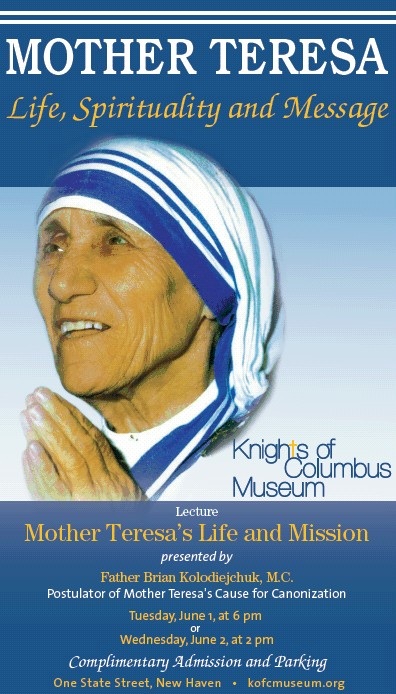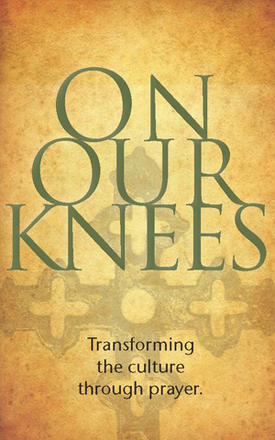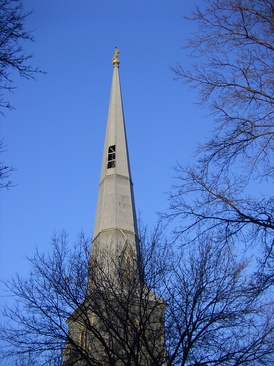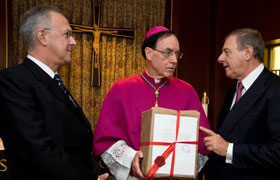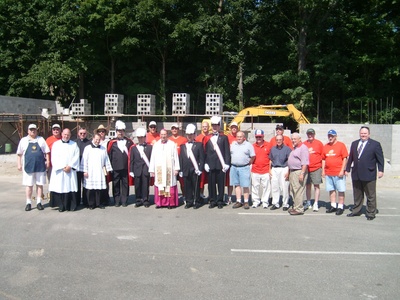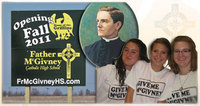 My friend Robin in Glen Carbon, IL, let me know about a fund raising opportunity for a new Catholic high school, Fr McGivney Catholic High School.
My friend Robin in Glen Carbon, IL, let me know about a fund raising opportunity for a new Catholic high school, Fr McGivney Catholic High School.
Tag: Knights of Columbus
Pius XII’s previously unpublished letter to FDR
The Zenit.org news agency gave its readers a previously
unpublished letter sent by Pope Pius XII to President Franklin Delano Roosevelt
on Aug. 30, 1943, after the Allied Forces bombed Rome. The letter surfaced from the archives of the Knights of Columbus given that it has worked in Rome since 1920. The KofC has recently opened a retrospective exhibit of its work for the Church and humanity in Rome. An unexpected gifts. Why? Because the letter to Roosevelt shows that Pope Pius did advocate for the needs of the defenseless in a dark period of history and that neither Italy nor the Church were free to freely act. Also, the exhibit shows the kind solicitude the KofC has had and continues to have for the work of Christ and the Church.
Your Excellency,
Recent
events have naturally focused the world’s attention for the moment on Italy, and
much has been said and written on what policy she would or should now follow
for her own best interests. Too many, we fear, take for granted that she is
entirely free to follow the policy of her choice; and we have wished to express
to Your Excellency our conviction that this is far from true. Of her desire for
peace and to be done with the war, there can be no doubt; but in the presence
of formidable forces opposing the actuation or even the official declaration of
that desire she finds herself shackled and quite without the necessary means of
defending herself.
If under such circumstances Italy is to be forced still to
bear devastating blows against which she is practically defenseless, we hope
and pray that the military leader will find it possible to spare innocent civil
populations and in particular churches and religious institutions the ravages
of war. Already, we must recount with deep sorrow and regret, these figure very
prominently among the ruins of Italy’s most populous and important cities.
But
the message of assurance addressed to us by Your Excellency sustains our hope,
even in the face of bitter experience, that God’s temples and the homes erected
by Christian charity for the poor and sick and abandoned members of Christ’s
flock may survive the terrible onslaught. May God in His merciful pity and love
hearken to the universal cry of his children and let them hear once more the
voice of Christ say: Peace!
We are happy of this occasion to renew the
expression of our sincere good wishes to Your Excellency.
From the Vatican,
August 30, 1943
Pius PP XII
Mother Teresa: Life, Spirituality & Mission –a New Haven lecture
National Prayer for Life Campaign launched
Yesterday, May 3rd,
marked the 10th Anniversary of the entrance into eternal life of John Cardinal
O’Connor.
Many of you were able to be present -and others were present through
EWTN–and shared prayer with us for the Cardinal’s eternal peace and God’s
mercy. In case you want see the video coverage, you may watch it here and
I suspect that EWTN will run the program again.
At the end of the Mass,
Archbishop Timothy Dolan launched and introduced a new effort of the Knights of
Columbus and the Sisters of Life called the National Prayer for Life
Campaign.
Please join us in praying this
prayer every day and give it to others; all of us are hoping that it spreads
throughout our nation so that a Culture of Life may be fully restored!
High winds cause damage to steeple, St Mary’s New Haven
Some have bats, we’ve got holes! Big, dangerous holes!
Civilization of Love launched in Italian
A Civilization of Love – What Every Catholic Can Do to
Transform the World (2008) by Carl Anderson, the head of the Knights of Columbus has a
new edition, Una Civilta dell’Amore.
Watch the book launch (video
clip) in Rome and read a CNA news brief and a review
of the book.
I also recommend the book.
McGivney’s cause for beatification takes another step
The cause for beatification and eventual sainthood of Father Michael J. McGivney, founder of the Knights of Columbus, took
another step on September 22, 2009, with the submission of a supplemental report on
a potential miracle attributed to the priest’s intercession.
The Knights of
Columbus announced today that officials from a supplemental tribunal of the
Archdiocese of Hartford -of which Fr. McGivney was a parish priest- formally
sent a new report to the Vatican’s Congregation for the Causes of Saints
through Dr. Andrea Ambrosi, the current postulator of McGivney’s cause. The
information gathered by the tribunal included testimonies from witnesses to the
supposed miracle as well as the statements of several medical doctors about the
circumstances surrounding the reported miracle. Dominican Father Gabriel B. O’Donnell,
the current vice-postulator and former postulator, has worked on the cause for a number
of years with the assistance of a variety people, not least was Millie Millea, the
former secretary at the McGivney Guild.
In the context praying Sext (midday
prayer), the brief ceremony in which the new report was signed and presented to
Archbishop Henry J. Mansell was attended by Supreme Knight Carl Anderson, other
Supreme Officers and other Knights of Columbus officials, three relatives of
Father McGivney and a number of archdiocesan officials.
The submission of the
new report “marks an important step forward. The Vatican’s Congregation for the
Causes of Saints will now have valuable additional testimony that clarifies and
adds significantly to the original submission,” Supreme Knight Carl Anderson
said.
“Father McGivney’s beatification would be an important event,” Anderson
added, “not only for Knights of Columbus, but for the many thousands of parish
priests who quietly do the Lord’s work in parishes each day and regard him as
an outstanding example for priests everywhere. In this ‘Year for Priests’
it is an especially appropriate step forward.” When beatified, McGivney will be
the first US diocesan priest beatified.
The cause for Father McGivney’s
sainthood was opened by Hartford Archbishop Daniel A. Cronin in December 1997. In 2000, the cause was presented to the Congregation for the Causes of Saints; Pope Benedict XVI declared
him “Venerable Servant of God” on March 15, 2008.
Father McGivney founded the
Knights of Columbus in 1882 and died on August 14, 1890 at the age of 38. At the time of
the founding of the Knights of Columbus he was a curate at Saint Mary’s Church
(New Haven, CT).
For pictures of the event see this link.
[this articled was first published at CNA and edited for
clarity]
Newtown, CT Knights dedicated new space: Moritz Hall
On Saturday August 16th Bishop Lori blessed the grounds of
the new Council 185 Meeting and Storage building which will be named Moritz
Hall.
The Moritz Hall derives its name from PGK Len Moritz who has been a major
force assuring completion of this four year project.
The hot day was part of a
Saint Rose of Lima (Newtown, CT) hosted Fan the Fire Youth Rally. Over 600 teens from all
over the diocese spent the day participating in renewal, witness and
confession. The day ended with a sunset Mass celebrated by Bishop Lori,
Monsignor Robert Weiss and a host of concelebrants. Vivat Jesus!
Antonella Cappuccio: Contemporary Italian Paintings
 The Knights of Columbus Museum is hosting an exhibit of an artist who has painted popes and scenes relevant to our human reality. Some hail Antonella Cappuccio as reviving a renaissance sense of painting. I like her work because it is evocative. See for yourself: the exhibit runs until October 4th.
The Knights of Columbus Museum is hosting an exhibit of an artist who has painted popes and scenes relevant to our human reality. Some hail Antonella Cappuccio as reviving a renaissance sense of painting. I like her work because it is evocative. See for yourself: the exhibit runs until October 4th.
Called to Love: Approaching John Paul II’s Theology of the Body
This new book, Called to Love: Approaching John Paul II’s Theology of the Body, due to be released on April 14, discusses John Paul II’s theology of the body and the meaning of human love. This interview appeared in the April 2009 issue of Columbia magazine, the organ of communication of the Knights of Columbus. I am grateful for the opportunity to re-publish it here.
By the Columbia Staff
From 1979 to 1984, Pope John Paul II delivered 129 Wednesday audiences in which he presented a vision of the human person, created as a unity of body and soul, and the vocation of every person to love. The pope’s catechesis, which has become known as the “theology of the body,” is considered by many to be revolutionary, as it develops profound truths about man’s most basic experiences — who we are and who we were created to be.
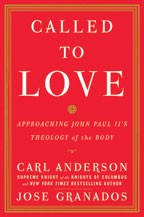 A new book about the theology of the body, which is being published this month, was co-authored by Supreme Knight Carl A. Anderson and Father José Granados, assistant professor at the Pontifical John Paul II Institute for Studies on Marriage and Family at The Catholic University of America in Washington, D.C. Titled Called to Love: Approaching John Paul II’s Theology of the Body (Doubleday), the book sheds light on the significance and implications of the pope’s insights.
A new book about the theology of the body, which is being published this month, was co-authored by Supreme Knight Carl A. Anderson and Father José Granados, assistant professor at the Pontifical John Paul II Institute for Studies on Marriage and Family at The Catholic University of America in Washington, D.C. Titled Called to Love: Approaching John Paul II’s Theology of the Body (Doubleday), the book sheds light on the significance and implications of the pope’s insights.
Father Granados: Theology does not only deal with our questions about God; it deals mainly with God’s word to us — that is, the way he talks with us and tells us about himself and his love for us. For theology, the Incarnation is central, this event in which God himself comes to meet us and becomes visible by assuming a human body. Because of the Incarnation, the body enters into the realm of theology. When the Word became flesh, God made clear to us that the body has a language able to talk about God and about the way he calls us to love him and each other.
Central to John Paul II’s insights is the concept of the communion of persons, which he sees as a reflection of the Trinity. In what way does the pope develop the traditional doctrine?
Father Granados: The good news of Christianity is that God is love, a communion of persons in which the Father gives himself totally to the Son in the union of the Holy Spirit. John Paul II has developed an understanding of the human person in the light of this Trinitarian love. Human love, and particularly the love of the family — between husband and wife, parent and child, brothers and sisters — is the mirror in which God’s love shines in the world, and man is able to share in it. John Paul II has taken this central theme of the tradition and has interpreted, in this light, the whole of man’s vocation and destiny.
What might people gain from studying the theology of the body? What inspired you to write this book?
Father Granados: The aim of this book is to help the reader discover the great vocation to which God calls him: a vocation to love. We often live unaware of this great call to love and thus are unable to give an answer to it. Because of this, our lives risk being wasted, without attaining their fulfillment. Through this book, we would like to reawaken the reader to the great news of his existence, to the wonder of God’s original plan for him. This means that the theology of the body is not only a teaching about human sexuality, but it also contains a whole understanding of the human person and of the world. In fact, John Paul II’s aim is to give an account of the whole of reality in terms of love.
Even before becoming Pope John Paul II, Karol Wojtyla had decades of pastoral experience and wrote on matters related to marriage and family. Why is the family so important, and what does the theology of the body teach us about the nature of human love?
Father Granados: According to John Paul II, the family is the place where we discover who we are. The pope speaks in this regard of the genealogy of the person. Our identity as human persons is formed in the family. The fact that we are children of our parents, for example, is not something accidental, but constitutes a central part of our being. The same is true for a parent; it is not just that a person has a child, but that he is a father or mother. In the family, we understand that we come from another as children and are called to become spouses and parents. In other words, one’s life is defined by an original love that is first received, as a child, and then given to another in order to be fruitful.
Beginning with man’s “original experiences” in the first chapters of Genesis, the catechesis on the theology of the body is, in a way, a Scriptural commentary about human nature. What role does Christian revelation play in understanding who we are? Can we explain John Paul II’s insights in secular terms?
Father Granados: Modern man suffers from a crisis of identity. We need to know who we are and what our path in life is. In the book of Genesis, John Paul II saw the genetic code of our identity as human beings. For instance, the pope talks about an original solitude: Adam realizes in the garden that he is alone. This experience is interpreted in the light of man’s relationship with the Creator, the only one who fulfills our expectations and desires. This means that our identity is always constituted before the mystery of God, as creatures who come from him.
John Paul II then adds the experience of unity: We only know who we are and how to reach God when we encounter another person through love. Precisely because the pope starts with an analysis of human experience, the theology of the body is universal and refers not just to Christians. Every human being asks himself about the meaning of life and how to find fulfillment. The theology of the body answers these questions in terms of love.
The book is being released one year after Pope Benedict XVI’s visit to the
Father Granados: At the beginning of his pontificate, Benedict said that he did not want to write much, because he conceived his mission as making John Paul II’s great work better known. In fact, Benedict’s first encyclical, Deus Caritas Est (God is Love) was a continuation of John Paul II’s work on love. Like his predecessor, Benedict takes as his point of departure the way Christ reveals to man his own vocation. In Deus Caritas Est, he writes that in order to give a good definition of love, we will need to start by looking at the Crucified one (12). It is at the foot of the Cross that we learn what love is all about.
